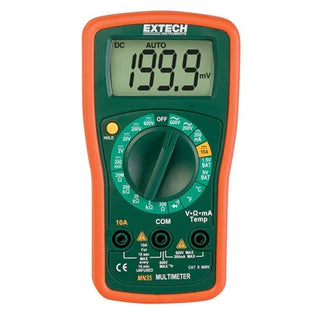
Introduction to Digital Multimeters: Types and Applications
Digital multimeters
Digital multimeters, also known as DMMs, are electronic devices used to measure various electrical quantities. These versatile tools can measure voltage, current, resistance, and other parameters. They are widely used in the fields of electronics, electrical engineering, and telecommunications, among others. In this blog post, we will discuss the basics of digital multimeters, their types, and applications.
A digital multimeter typically consists of a display, a rotary selector switch, and two or more probes. The display shows the measured value in digits, which makes it easy to read and interpret. The rotary selector switch is used to select the type of measurement, such as AC or DC voltage, current, or resistance. The probes are used to connect the multimeter to the circuit being measured. Some DMMs also have additional features, such as a continuity test, diode test, and capacitance measurement.
Types of digital multimeter
There are two main types of digital multimeters: handheld and benchtop. Handheld multimeters are portable and can be used in the field or on the go. They are usually battery-powered and have a compact design, making them easy to carry around. Benchtop multimeters, on the other hand, are designed for use in a laboratory or workshop. They are larger and more accurate than handheld multimeters, and they usually have a higher resolution and more advanced features.
Digital multimeters are used in a wide range of applications. They are commonly used to troubleshoot electrical circuits and diagnose faults. For example, a DMM can be used to measure the voltage across a component to determine if it is working properly. They can also be used to measure the current flowing through a circuit to ensure that it is within safe limits. Additionally, DMMs can be used to measure resistance, which is useful in determining the value of a resistor or to check for continuity in a circuit.
Digital multimeters are also used in the design and testing of electronic circuits. Engineers and technicians use DMMs to measure the performance of circuits and components. For example, a DMM can be used to measure the frequency of an oscillator, or to measure the output voltage of a power supply. They can also be used to measure the capacitance of a capacitor, which is important in the design of filters and other circuits.
Conclusion
In conclusion, digital multimeters are an essential tool for anyone working with electrical circuits. They are versatile, easy to use, and provide accurate measurements of various electrical parameters. Handheld multimeters are ideal for field use, while benchtop multimeters are suitable for laboratory and workshop use. Digital multimeters are used in a wide range of applications, including troubleshooting, diagnosis, design, and testing of electronic circuits. If you are working with electrical circuits, a digital multimeter is a must-have tool that will make your work easier and more efficient.
Check out all of our measurement equipment here!

